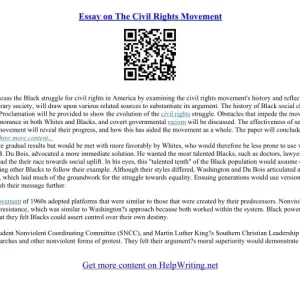
Southern Education: Then & Now – A Look at Progress and Challenges
The sun-drenched landscapes of the South have long been interwoven with the narrative of education, a story marked by both profound struggles and remarkable advancements. From the antebellum era’s limited access to the digital age’s evolving challenges, the educational journey in the South presents a complex tapestry of progress and persistent hurdles. This exploration delves into the past, present, and future of Southern education, examining its triumphs and tribulations through a unique lens.
Then: A Legacy of Inequality
Before the Civil Rights Movement, Southern education was deeply segregated and unequal. The legacy of slavery cast a long shadow, with Black communities systematically denied access to quality education. “Separate but equal,” a cruel fiction enshrined in Plessy v. Ferguson, resulted in vastly underfunded and substandard schools for African Americans. These schools lacked resources, experienced teacher shortages, and often operated in dilapidated buildings. Meanwhile, white students enjoyed significantly better facilities and opportunities. This disparity wasn’t merely about bricks and mortar; it was a systemic denial of opportunity, hindering social mobility and perpetuating economic inequality for generations. Even beyond the racial divide, access to quality education was often determined by socioeconomic status, with rural communities disproportionately affected by limited resources and opportunities.
The Seeds of Change: Civil Rights and Beyond
The Civil Rights Movement served as a watershed moment, challenging the deeply entrenched system of segregation. Landmark legislation like the Civil Rights Act of 1964 and the Elementary and Secondary Education Act of 1965 aimed to dismantle discriminatory practices and provide equal educational opportunities for all. Desegregation, however, was a slow and often painful process, met with resistance in many Southern communities. The fight for equal access continues to this day, as the lingering effects of historical inequities manifest in persistent achievement gaps.
Now: A Landscape of Progress and Persistent Gaps
While significant strides have been made, Southern education continues to grapple with complex challenges. Progress is evident in increased access to higher education, the rise of diverse educational institutions, and greater representation among educators. However, disparities persist. Achievement gaps based on race, socioeconomic status, and geographic location remain stark realities. Funding inequalities continue to plague many Southern school districts, leading to discrepancies in resources, teacher quality, and educational opportunities. Furthermore, the South faces unique challenges, such as a high concentration of rural schools often lacking the resources and skilled teachers found in urban centers.
Table: Key Indicators of Southern Education (Simplified)
| Indicator | Then (Pre-Civil Rights) | Now |
|---|---|---|
| Access (Black Students) | Severely Limited | Significantly Improved, but Gaps Remain |
| Funding | Vastly Unequal | Unequal, with persistent funding disparities |
| Teacher Quality | Significant Shortages (Black Schools) | Shortages persist in certain areas |
| Infrastructure | Often dilapidated (Black Schools) | Varies widely by district and location |
Challenges on the Horizon: The Digital Divide and More
The digital age presents both opportunities and challenges. While technology offers immense potential for enhancing education, the digital divide poses a significant obstacle. Unequal access to technology and reliable internet connectivity exacerbates existing inequalities, leaving many students, particularly those in rural or low-income communities, behind. Furthermore, the South continues to grapple with issues such as teacher retention, attracting and retaining high-quality educators in often under-resourced districts.
Looking Ahead: Fostering Equity and Excellence
To ensure a brighter future for Southern education, a multifaceted approach is essential. Increased and equitable funding for schools, particularly those serving historically marginalized communities, is paramount. Investing in teacher recruitment and professional development, along with strategies to address teacher shortages, is crucial. Bridging the digital divide through expanded access to technology and reliable internet connectivity is equally vital. Finally, fostering a culture of equity and inclusivity within schools and communities remains a continuous and essential endeavor. The journey towards equitable and excellent education in the South is ongoing, demanding sustained commitment and collaborative efforts from policymakers, educators, communities, and individuals alike. The legacy of the past calls for a future where every student, regardless of background or location, has the opportunity to thrive.
Additional Information
Southern Education: Then & Now – A Deeper Dive into Progress and Persistent Challenges
While a general overview of Southern education might highlight progress since the Civil Rights era, a deeper analysis reveals a complex tapestry of advancements interwoven with persistent inequalities. Simply stating “progress has been made” obscures the nuanced reality of significant disparities that continue to plague the system. This deeper dive examines key areas, revealing the complexities and offering potential solutions.
1. The Legacy of Segregation and its Lingering Effects:
The formal dismantling of segregation didn’t erase its deep-seated impact. Decades of disinvestment in historically Black colleges and universities (HBCUs) and Black schools created a funding gap that persists today. This manifests in several ways:
- Resource disparities: Schools in predominantly Black districts often lack resources compared to predominantly white districts. This includes funding for advanced technology, well-equipped libraries, experienced teachers, and extracurricular activities. The achievement gap directly correlates with this resource disparity. For example, the Southern Education Foundation’s research consistently reveals significant differences in per-pupil spending between predominantly white and predominantly Black districts within many Southern states.
- Teacher quality: Recruitment and retention of highly qualified teachers in underserved areas remain a critical challenge. Factors like lower salaries, lack of professional development opportunities, and higher stress levels contribute to teacher shortages, particularly in subjects like STEM. This disproportionately affects students in predominantly Black schools, perpetuating the cycle of inequality.
- Curriculum and Pedagogy: The curriculum in some schools may still subtly reflect historical biases, neglecting the contributions of Black Americans and other marginalized groups. Furthermore, pedagogical approaches may not be culturally responsive to the diverse student populations found in many Southern schools.
2. Economic Disparities and their Educational Consequences:
Poverty significantly impacts educational outcomes. The South historically has higher poverty rates compared to other regions, impacting access to quality education. This is reflected in:
- High school graduation rates: Although graduation rates have improved, significant disparities remain based on race and socioeconomic status. Students from low-income families, particularly in rural areas, face numerous challenges that hinder their ability to complete high school.
- College enrollment and completion: The cost of higher education remains a significant barrier for many Southern students, particularly those from low-income backgrounds. While Pell Grants and other financial aid programs exist, they often fall short of covering the full cost of tuition, fees, and living expenses. This leads to higher rates of student loan debt and lower college completion rates, especially among minority students.
- Early childhood education: Access to high-quality early childhood education is crucial for school readiness. However, many Southern states still face significant challenges in providing affordable and accessible preschool programs, exacerbating inequalities before children even enter kindergarten.
3. Progress and Positive Developments:
It’s crucial to acknowledge positive changes:
- Increased access to higher education: More Southern students are attending college than ever before, reflecting increased awareness of the importance of higher education and expanded access to financial aid. The growth of community colleges has also provided more affordable pathways to higher education.
- Growing emphasis on STEM education: Many Southern states are investing in STEM initiatives to prepare students for in-demand jobs in science, technology, engineering, and mathematics.
- Increased focus on teacher training and professional development: Efforts are underway to improve teacher training programs and provide ongoing professional development opportunities to enhance teacher quality and effectiveness.
4. Future Directions and Policy Recommendations:
Addressing the ongoing challenges requires a multi-pronged approach:
- Increased and equitable funding: Significant increases in state and federal funding for education are needed, with a focus on equitable distribution to address resource disparities between districts. This includes targeted investments in HBCUs and schools in underserved communities.
- Comprehensive early childhood education: Expanding access to high-quality, affordable early childhood education programs is crucial to ensuring that all children enter kindergarten ready to learn.
- Targeted interventions for at-risk students: Implementing evidence-based interventions to support students from low-income families and those facing other challenges can significantly improve their academic outcomes.
- Teacher recruitment and retention strategies: Attracting and retaining highly qualified teachers in underserved areas requires competitive salaries, comprehensive benefits packages, and robust professional development opportunities.
- Culturally responsive curriculum and pedagogy: Curriculum should reflect the diversity of the student population and incorporate culturally responsive teaching methods to better engage all learners.
In conclusion, understanding the complexities of Southern education requires a nuanced perspective that acknowledges both progress and persistent challenges. Addressing these challenges demands sustained commitment to equitable funding, effective policies, and innovative approaches that prioritize the needs of all students, ensuring that the promise of a quality education is accessible to every child regardless of their background or location. Further research focusing on specific state-level data and longitudinal studies tracking student outcomes will be crucial for ongoing evaluation and informed policymaking.





